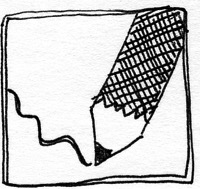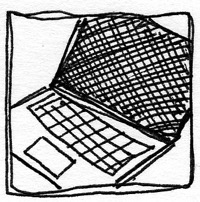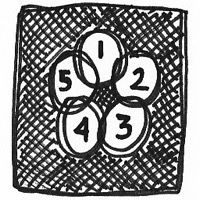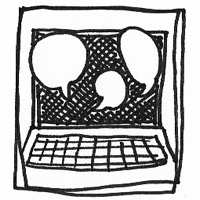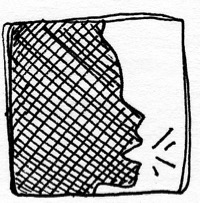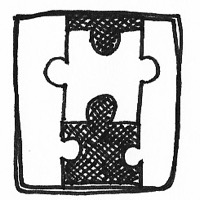In this webtext, we discuss our IRB-approved study of the integration of multimodal modules in online technical communication classes (eTC) at our institution: an urban, Research 1 university. The syllabus for our course is available here. On the syllabus's third page, readers get a quick gloss of the course's three major assignments (instructions, analytical report, and recommendation report), all of which are explicitly multimodal, as well as the portfolio. These assignments strive to introduce students to key genres and composition practices foundational to the technical and professional communication (TPC) field today.
Our eTC courses integrate multimodality through instructional tools (video lectures, podcasts, blogs, etc.) and course curriculum, including assignments and discussion board prompts that ask students to create multimodal texts, or texts that use more than one mode to communicate. While we acknowledge Cheryl Ball and Colin Charlton's (2015) argument that all texts are multimodal (p. 42), we choose the term, and teach our courses, with an emphasis on multimodal composition, as the term multimodal connotes process work and multimedia suggests a finished product. As Claire Lauer (2013) suggested, the term multimodal implies "the cognitive and socially-situated choices a student or scholar makes while in the process of composing a text, before it enters into final production and distribution" (p. 236). As this class sought to foster a deeper understanding of those composing process and the reflection of that process specifically, we were intentional about our use of multimodal in the class and within this webtext. (See also Beth Hewett, Tiffany Bourelle, and Scott Warnock's 2021 Teaching Writing in the Twenty-First Century for more guidance on the terms multimodal and multimedia.)
With well-planned videos punctuating the course design, students grew attuned to a culture of multimodal communication from the course's start. Like Sherry Rankins-Robertson, Tiffany Bourelle, Andrew Bourelle, and David Fisher (2014), we call these videos and other digital media multimodal instructional tools, as they can be used to model multimodality for students. Indeed, in our courses, we often use such instructor-created multimodal tools within discussion boards, asking students to consider the rhetorical decisions the authors made and the overall effectiveness of the medium and message. Much like the multimodal curriculum we adopt, we design the course using multimodal instructional tools to not only encourage deeper learning of course concepts (Mayer & Moreno, 2003) but also to encourage the formation of a community of learners, as we discuss further in the section Community Through Multimodality. The video below provides an example of such instructional tools, introducing students to multimodal communication and framing the work they will produce in their major and minor writing/production/design assignments throughout the semester.
Other classroom components, such as discussion boards and peer review workshops, also frame the class as a localized community context in which communication emerges. This frame, we suggest, encourages students to become multiliterate learners within the online community and the larger communities in which they live as they learn to interact with peers using a multiplicity of modes of communication (as mentioned in the introduction, we ask students to reflect on this work through the canon of Memory). In the eTC class, our students are beginning to understand what the TPC field is, developing an understanding that the work of a technical writer is often collaborative and requires learning that, as Sharan B. Merriam and Rosemary S. Caffarella (1991) explained in their elaboration on Jean Lave and Etienne Wegner's Communities of Practice (CoP), happens by "observing other people" (p. 134). Functionally in our eTC classes, such "observations" take place in a version of the "social setting" Merriam and Caffarella described, a version that is an online community of learners. Through interactions that take place in small group work and in discussion boards (which we share in this webtext), our eTC courses strive to foster community cohesiveness that coalesces around multimodal interaction, following the guidance given by many authors in Kelli Cargile Cook and Keith Grant-Davie's (2005) Online Education: Global Questions, Local Answers , by scholars who study other iterations of online community formation (Holmes, 2017), and by scholars who specialize in online pedagogy as specifically applied to the teaching of TPC (Hewett & Bourelle, 2017).
In this webtext, we suggest that designing an online course that focuses on multimodality and community building—where community encompasses the online space and the larger society and can be uniquely fostered by metacognitive engagements—can promote student success as literate citizens in the digital world within and beyond academia. As we indicate, metacognitive reflection of their work in the class, in our case linked to the canon of Memory, can guide students to reconsider how elements of the course can affect their learning in the course and their work within their future careers. Through this discussion, we connect arguments made by Stewart Whittemore (2015), Gunther Kress and Theo Van Leeuwen (2001), and Collin Brooke (2000, 2009). While Andrew Bourelle, Tiffany Bourelle, and Natasha Jones (2015) have argued for online technical communication curricula to not neglect the whole range of rhetorical canons, as "a more comprehensive discussion of the canons is relevant in the digital world and can be used to effectively teach multimodality in technical communication" (p. 310), we focus in this webtext on the way our eTC course uses Memory, specifically (though alongside the other canons), to promote metacognitive reflection. We target here this particular canon's efficacy in fostering a "praxis of memory," as Katherine Gossett (2008) has explored, that is uniquely suited, and long has been, to engagement with and production of multimodal texts that are often produced and consumed communally. Further, as Bourelle, Bourelle, and Jones (2015) suggested, based on Kathleen Blake Yancey's (2004) call for more integration of the canons in the digital age, the canons, with their focus on rhetorical composing strategies, can be especially useful for students when considering the nuanced choices they make when composing multimodally, specifically when recognizing how these skills improve and transfer across multiple projects. In this webtext, we extend this argument, noting the importance of Memory in regard to reflection. Indeed, reflection also has a long history with multimodal composition, and thus attention to reflection through the rhetorical canon of Memory seemed like a natural fit within our courses. (See Jody Shipka's 2011 Toward a Composition Made Whole for more guidance on using reflection alongside multimodal projects.)
Our course framework within the Blackboard Learn Learning Management System (LMS) foregrounded concepts of multimodality and community from the students' first engagement with the course, from the course LMS's landing page, to the "Start Here!" page, to each Student Learning Outcome (SLO) reflection discussion board prompt. Video 1, below, is material students encountered in week 1 of their course and it introduced them to the SLO terminologies that organized the class: the classical rhetorical canons of Invention, Arrangement, Style, Delivery, and Memory. The transcript for this video is available by clicking here.
The sections in this webtext pace readers through many of our course documents and students' multimodal reflective output, as connected via theories concerning multimodality, online TPC learning, and the rhetorical canon of Memory. We focus most intently on the students' end-of-term reflections. Throughout, the evidence we offer in this webtext exhibits our pedagogical deployment of Memory as enacted through multimodal reflective activity, as specifically tied to the creation of a class community that both enhances student learning and supports entrance into the larger technical communication community beyond academia.

